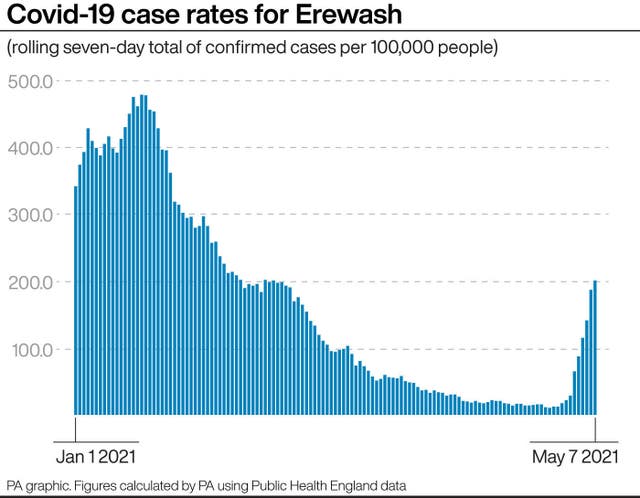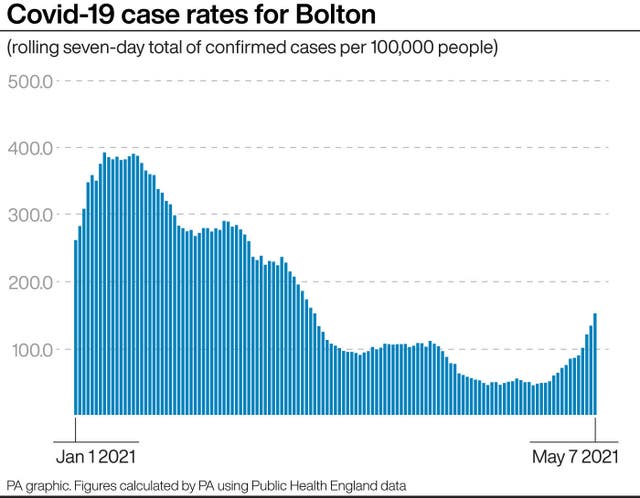Covid-19 hotspots: Where are they and why have cases increased?
A handful of local areas have seen rates increase sharply in recent days.

Covid-19 case rates in most areas of the UK have returned to levels last seen around eight months ago, with the number of new cases of coronavirus similar to those recorded in late August and early September.
Some 370 of 380 local areas – 97% – are currently recording rates below 50 cases per 100,000 people, with nearly one in four having rates that have dropped into single figures, according to analysis by the PA news agency.

But a small handful of areas are currently experiencing a jump in cases, which have pushed rates back to levels last seen earlier this year.
While rates in these areas have yet to reach the sort of levels recorded at the peak of the second wave, the latest figures suggest localised outbreaks of Covid-19 are continuing to occur, driven by a range of factors.
– Erewash: 201.1 cases per 100,000
Erewash in Derbyshire currently has the highest case rates of any local area in the UK.
A total of 232 new cases were recorded in the seven days to May 7 – the equivalent of 201.1 per 100,000 people, up from 21.7 in the previous week and the highest for the area since February 18.
The sharp rise in case rates has been driven by an outbreak at Wilsthorpe Academy in the town of Long Eaton, according to Derbyshire County Council’s director for public health, Dean Wallace.

“The significant outbreak of Covid-19 at Wilsthorpe Academy continues to affect case numbers in the area,” he said on Tuesday.
“As Covid rates across Derbyshire have been relatively low, any increase in numbers can have a large impact on the figures for that area. I understand this will cause concern, but I’d like to reassure residents that we continue to work closely with the school and Public Health England to minimise the spread.”
The school remained closed last week, but is due to reopen in stages this week.
There is no evidence that the outbreak is a new variant of Covid-19 or a variant of concern, Mr Wallace added.
– Moray: 93.9 cases per 100,000
Moray currently has the highest rate in Scotland, with 90 new cases of Covid-19 recorded in the seven days to May 7.
This is the equivalent of 93.9 cases per 100,000 people – down slightly on the previous few days, but still at a level not recorded in the area since the end of January.
Scotland’s chief medical officer, Dr Gregor Smith, said the outbreak is thought to consist of 21 significant networks, with infections in a number of settings including schools, workplaces and large shops.
The towns of Elgin and Keith are particular hotspots, he said, but there does not appear to be a spread into neighbouring local authorities such as the Highlands and Aberdeenshire.
Genome sequencing indicates that the Moray outbreak consists of the B117 strain of Covid-19 – the variant that first emerged in Kent in late 2020 and which is now dominant in the UK.
The demographic of those testing positive is slightly younger than overall, he said, adding: “We’ve had, unfortunately, some hospital admissions for older age groups as a consequence of this outbreak as well.”
National clinical director Jason Leitch confirmed that the outbreak appears to have slowed in recent days, but officials are still monitoring the situation.
– Bolton: 152.0 cases per 100,000
Bolton in Greater Manchester has the second highest rate in the UK, with 437 new cases of coronavirus recorded in the seven days to May 7.
The rate has jumped from 74.4 to 152.0 in a week – the highest since the seven days to February 28.

Surge testing has been under way in parts of Bolton since May 7, after Public Health England (PHE) confirmed the town is one of the main locations for cases of the India variant of Covid-19, which last week was reclassified as a variant of concern.
Cases of the India variant in England had increased from 202 to 520 as of May 7, PHE said, with almost half related to travel or contact with a traveller.
The majority of the cases are concentrated in two areas: north-west England, predominantly Bolton, and London.
Greater Manchester Mayor Andy Burnham has submitted a request to the Joint Committee on Vaccination and Immunisation that all over-16s in Bolton, along with the rest of the Greater Manchester area, are able to receive a Covid-19 vaccination “to mitigate the risks of spread in those communities where we are seeing more transmission”.
– Blackburn with Darwen: 90.2 cases per 100,000
This is the third highest rate in England, with 135 cases recorded in the seven days to May 7.
The current rate of 90.2 is up from 52.1, to levels last seen at the end of March.
Blackburn with Darwen borders Bolton to the north, so is likely to have been affected by the jump in cases experienced by its neighbour.
Surge testing has yet to be rolled out within the local authority, however, and the presence of the India variant has still to be confirmed.





